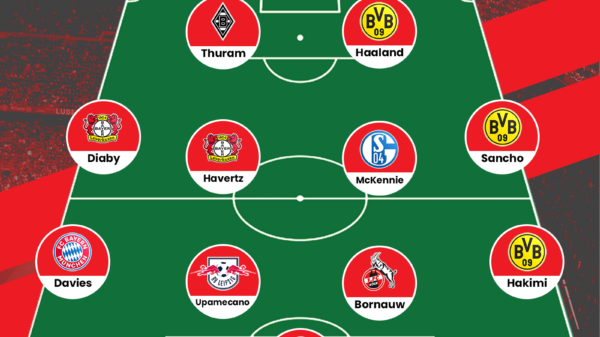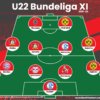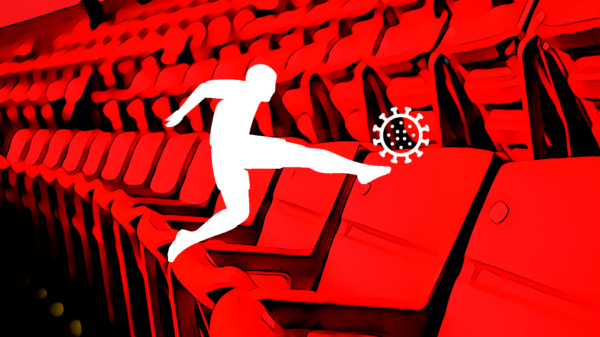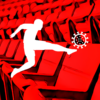With Bayern Munich predictably marching ahead in the title race, the chasing pack had a very important match on Saturday night. Leverkusen travelled to the Signal Iduna Park to face the third placed side, Borussia Dortmund.

Made via TacticalPad.
Line Ups:
Dortmund: Weidenfeller; Grosskreutz; Sokratis; M. Friedrich; Durm; S. Bender (Reus, 63); Sahin (Pisczcek, 82); Kuba (Hoffman, 67); Mkhitaryan; Aubemayang; Lewandowski.
Leverkusen: Leno; Donati; Spahic; Toprak; Can; Rolfes; L. Bender; Castro (Kohr, 89); Hegeler (Kruse, 78); Son (Wollscheid, 82); Kiessling.
Analysis
Formations
Dortmund started the game with a 4-2-3-1, but a very unfamiliar back 4 owing to injuries. As usual, they looked to move the ball around quickly, win it high up the pitch, and attack the opposition. Later in the game, when Bender went off injured, Mkhitaryan took his place in central midfield, and was joined Grosskreutz, after Pisczcek came on for the injured Sahin.
Leverkusen began with 4-3-3, the injured Sidney Sam missing out, and Jens Hegeler taking his place in the side. Leverkusen’s basic strategy was to sit back, wait for Dortmund to attack them, and then launch the counter. They did this very well, moving the ball forward extremely quickly and troubling the makeshift Dortmund defence.
Crowded Middle
Leverkusen’s aim was to stop allow Der BVB to get forward, and then counter by moving into this space. To stop the flow of the Dortmund build up play and attack, they adopted two tactics. One, they pressed Dortmund high up, to test the make shift back line, and try and starve the midfield. Secondly, they kept the game very narrow. Whenever the Dortmund midfield did manage to get on the ball, the Leverkusen players engaged in some of the dark arts and committed some fouls to slow down the pace, or stationed themselves in a very narrow manner outside their penalty areas. This made it very difficult for Dortmund to attack Leverkusen with any sort of potency. They made 27 successful tackles and 14 interceptions through the game, a testament to their excellent defensive performance.
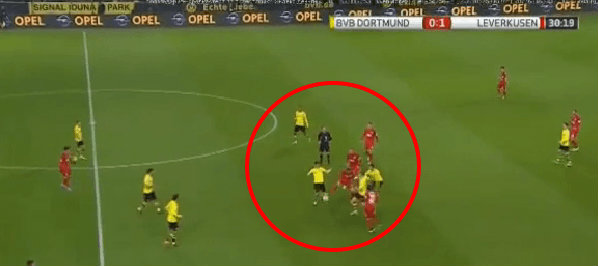
Leverkusen successfully stemmed the flow of Dortmund attacks by crowding the midfield and being aggressive.
Overall, Dortmund managed to complete only 78% of their passes, which is low by their standards, and couldn’t play a single successful through ball in the course of the match, an oddity considering the fact that some top talents like Mkhitaryan and Reus were on the field. Dortmund had more of the ball (55%), they just weren’t capable of making it count due to the excellent Leverkusen defence.

Leverkusen interceptions.
via squawka.com
In response, Dortmund had to use the wide areas, which were relatively free, to try and get crosses into the box. The trouble for Dortmund was that their usual defenders were absent. While much is made of the defensive capabilities of the likes of Hummels, their skills on the ball are often ignored, and the values that the team derives from having someone that plays out from the back is immeasurable. The same is the case with Marcel Schmelzer, whose terrific runs down the left tend to be taken for granted. Durm is a decent replacement, but not at the same level. Seeing as the middle was crowded, Dortmund had to build up from the wide areas. Normally, this wouldn’t be a problem, and it wasn’t much trouble for Grosskreutz, who managed to work well down the right hand side. On the left, Durm struggled to have an impact going forward. This meant that the likes of Kuba and Aubemeyang had to drift out wide to see the ball, leaving Lewandowski alone in the box. It also meant that Leverkusen had narrowed down their pressing options, as they had now forced Dortmund into playing from the wide areas. The front men like Son and Hegeler worked their socks off to do this job, and were thoroughly rewarded when a poor pass from Friedrich created the opportunity for Heung Min Son to score the winning goal. The front three all made two tackles each, a pretty good number for a front three.

Leverkusen stopping the Dortmund wingbacks.
via squawka.com
Despite this battle on the wings, Dortmund were keen to play crosses into the box, and managed to attempt an incredible number of them, 31. Of these 31, only 8 succeeded, and this was were Dortmund lost the match. Their prime attacking tactic didn’t really cut it for them. The crosses were not all of a very high quality, with a lot of them missing their target. Of the duels that did take place inside the penalty area, Leverkusen did well to keep Leno from having to make any tough saves. Speaking of Leno, he too performed well on the night, being especially good with the way he dealt with crosses into the box.
Ineffective Pressing
The biggest difference between Dortmund and a lot of the teams that have been beaten by them is the pressing. Dortmund press for long periods of the game, and press the opposition very hard. Inevitably, this leads them to making mistakes and goals for Dortmund. Even if the mistakes don’t come, it pressurizes the opposition, and helps in nullifying the attacking threat from the opposition. Today, against Leverkusen, Der BVB just couldn’t press well enough, and Leverkusen were quite comfortable on the ball, and were able to impose their will on Dortmund. This is something that will worry Jurgen Klopp, especially as it come right before a clash with Marseille in the Champions League. Of the 17 successful tackles, and 18 interceptions that Dortmund made during the course of the game, most were in their own half, which is slightly unusual for the former champions.

Dortmund Interceptions.
via squawka.com
Can Attacking Threat
As Arnab and Razim point out here, Emre Can is someone who is more accustomed to playing in the centre of midfield. He really struggled in the game against Manchester United, but the young player has grown since that game. He was a major plus for the visitors, doing attacking and defensive duties very well. In fact, he contributed more going forward that Donati did on the opposite side (he completed the highest number of dribbles in the match, 7), which might have contributed to Grosskreutz and Pisczcek being able to attack down the right. All in all, it was a good performance from Can, who has now given Hyypia a selection headache.
Conclusion
In what was a fairly evenly matched contest, Leverkusen came out on top because their attacking strategy worked better than that of Dortmund’s. The home side lacked the killer ball, and their crosses into the box didn’t yield fruitful results. For Klopp, this is slightly worrying just before a big game, and he will hoping for the swift return to fitness of key players like Bender, Gundogan and Pisczcek, so that they can get their season back on track.
Did you notice a tactical aspect of the game that we missed? If so, do leave a comment below. Make sure you follow us on Twitter @OOTB_football and like us on Facebook. We’re on Google+ and Tumblr as well for those interested.
CLICK HERE TO READ OUR OTHER TACTICAL ANALYSES
- Analysis: Are Chelsea’s pressing issues a concern? - October 5, 2020
- Has Financial Fair Play Been Worth It? - August 27, 2020
- Tactical Philosophy: Frank Lampard - May 20, 2020





















































